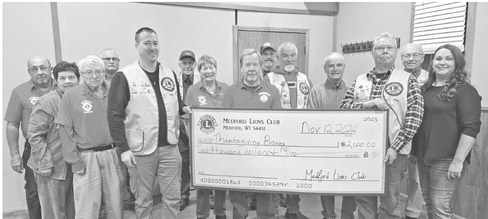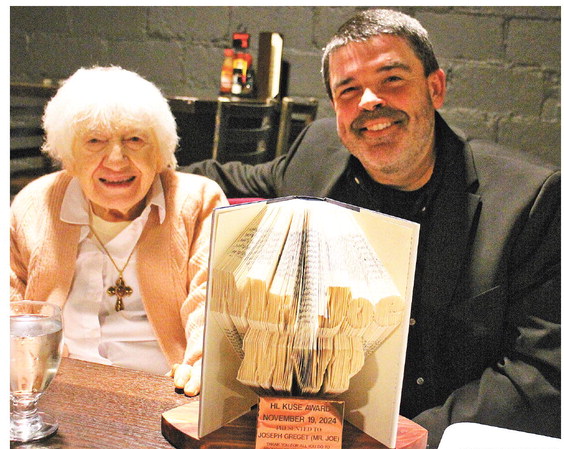Hirt explained the program was ….


Hirt explained the program was developed as a way to attract and retain volunteer firefighters. Hirt has been with the fire department for 31 years.
“We are hoping to get more involvement and get people to stay on longer,” Hirt said, noting that while the department is authorized for up to 30 firefighters it currently has only 24 firefighters who are on-call 24 hours a day, seven days a week.
Alderman Greg Knight questioned the impact it would have on city finances. Hirt explained the fire commission budget for next year already included $15,000 for the program so there would be no extra funds being requested other than the city’s regular share of the fire department budget. The cost of operating the Medford Area Fire Department is split between the city and surrounding towns with each responsible for a percentage of the expenses based on their percentage of the overall equalized value of the district. In recent years, as housing has grown in the towns, the city’s portion of the overall share of the department has gradually declined with the towns picking up more of the costs.
Council members unanimously approved recommending participating in the Wisconsin Service Awards Program.
Water tower
A third water tower for the city of Medford will cost more than what was originally projected. The tower, which will service the city’s north side and allow for additional growth in that area while resolving longtime water flow concerns, had an estimated cost of $1,048,600. When bids were opened on September 11, the low bidder was Maguire Iron of Sioux Falls, S.D. $1,296,850 followed by Phoenix Fabricators of Avon, Ind. at $1,625,813 and Caldwell Tanks of Louisville, Ken. at $1,748,000.
Maguire Iron has 29 active tower projects under contract at this time ranging in size from 50,000 gallons to 500,000 gallons in size. Their most recent closest tower was a 200,000 gallon tank for the city of Wausau.
According to city coordinator Joe Harris, while the cost of the water tower is slightly higher than anticipated, the bids for the related piping work came in below what was anticipated equalling the overall costs out.
The water tower, along with the east side sewer interceptor, are the two final major projects of Tax Incremental District (TID) No. 13. This is a special taxing district that snakes along Hwy 13 north of Hwy 64 and includes the Medford Walmart. Taxes on improvements in the district go toward paying for infrastructure upgrades as identified in the district’s project plans.
Under bid terms, the new tower must be in operation by January 2022.
Also as part of the TID No. 13 projects, the aldermen recommended paying property owner Harold Miller $5,000 for a permanent utility easement for phase 2 of the eastside sewer interceptor to cross his property to the east of the Taylor County fairgrounds.
Harris explained that the pipe will follow the river bottom that runs through the property. The sewer interceptor is a deep sewer collector pipe that will allow for gravity flow of sewage to the treatment plant without the need for lift stations.
Capital projects
Aldermen voted to recommend paying Ayres $133,400 for engineering for the following capital projects scheduled for 2021:
_ Reconstruction of Shattuck Street from approximately
150 feet north of Highland to approximately 1,250 feet to the north city limits.
_ Whelen Avenue water main replacement from water tower on Whelen Avenue to the wastewater facility’s driveway. This will be paid for from the water utility.
_ Allman Street from North Second Street to Jackson Street to include curb and gutter and asphalt.
In other projects, Harris reported the city drilled in a sewer line for the Jaycees Field concession stand bathrooms. Previously, the bathrooms were served with a holding tank. The public works department also poured the slab for a new garage storage building that will be built by Medford City Baseball for equipment storage. He reported that construction of the new building is being delayed due to the current spike in the price of lumber.
Budget
While city of Medford taxpayers will see little change in the overall city tax levy for 2021, there was a shift in how that money is being used as the city retires debt service.
Council members reviewed the 2021 city budget looking at spending in the various departments, construction and general operations. Under state rules, the city is limited to increasing its levy by the net new construction. New construction last year was $1,447,400 which will generate an additional $22,370 in the levy. As proposed, the 2021 budget does not call for any tax increase beyond what was gained through growth.
What is changing is how those tax dollars will be spent. City spending is similar to a three-legged stool with a portion of taxes, shared revenues and fees going to construction, a portion going to pay off existing debt and the remaining portion for general government operations, this includes everything from law enforcement to libraries, parks and city hall wages.
In 2017, the city paid out $515,000 in principal and interest on existing debt with that number dropping to $405,000 this year. The 2021 city budget sees that debt service obligation dropping nearly in half to $210,000. As the debt service decreases, this frees up local tax levy dollars to be spent in other parts of the budget. About $116,762 was added to the construction budget, bringing the total levy contribution to the construction fund to $812,964. This fund also covers the purchase of public works vehicles such as plow trucks. Under the proposed budget the amount of local tax levy dollars going to the general fund will increase by $125,708 to $896,849.
The local property tax levy is only part of city revenues with other revenues from taxes on the city utilities, state shared revenue and fees. The proposed budget for general city operations totals $3,738,812 up from the $3,630,358 budgeted for 2020.
According to Harris, the breakdown of overall city spending is 51% for the general fund, 46% for construction and 3% for debt service payments.
One question from council members was how the funds to cover Ginny Brost’s pay were being accounted for in 2021. Brost is retiring as city clerk at the end of the year, but the city is keeping her on as an executive assistant through 2021 to ease with the transition. Previously city council members had approved transferring up to $90,000 from city reserve funds to cover the additional cost.
However, Harris said the city will be able to cover the cost without dipping into reserves by using the wages and benefits budgeted for the Streets/Water Superintendent position he held prior to being appointed city coordinator. That position is scheduled to remain vacant over the next year as Harris completes his probationary period with the city. In addition, the budget includes $33,000 in temporary help.
Alderman Mike Bub called for the treasurer to create a new budget line item for Brost’s position so that in future years there will accounting of how it was spent. “I understand it doesn’t change the revenue,” Bub said, noting the impact would be to zero out some line items and shift the money into the new one to ease tracking of what was spent.
Bub also questioned the status of traffic control options that had been talked about in the community. He said he could understand not having things at every intersection to stop traffic, but suggested they should have something in the budget to get them for some specific intersections.
“Have we looked into it?” he asked.
Mayor Mike Wellner reported that the Rotary Club was looking at options and would be bringing ideas to the city council. “They are looking at a lot of different options,” Wellner said.
Alderman Clem Johnson noted that regardless of what intersection people are at, state law requires drivers to stop for pedestrians in the crosswalks.
“You are not supposed to speed either,” Harris said.
Wellner noted there was $50,000 set aside in the city’s contingency fund which could be tapped in order to pay for road crossing improvements if needed.


